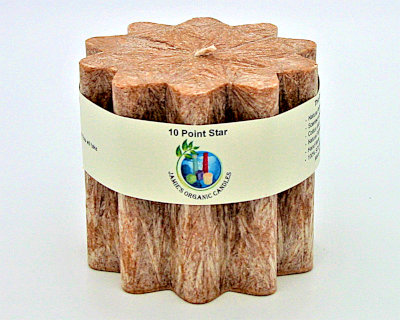Categories
ABOUT PALM WAX
Palm wax is an environmentally friendly product as it comes from a sustainable and renewable source and it burns cleanly. Palm cultivation is perhaps, the world's most environmentally friendly commercial crop.
We choose to buy our palm wax from Malaysia because its government has put a moratorium on forest clearing for the establishment of oil palm plantations. Only areas already used for agriculture will be allowed to convert to palm oil production. The oil palm has been grown as a commercial crop in well managed and regulated estates in Malaysia since 1917. The palm produces fruits in bunches which are harvested and sent to palm oil mills to undergo sterilization, bunch stripping, oil extraction, oil clarification and purification. This crude palm oil then becomes the raw material for palm oil refineries where it is further processed by neutralization, bleaching and deodorization.
The Refined palm oil then undergoes fractionation by which palm olein and palm stearin are produced and these in turn are further fractionated to obtain specialized products. These range from cooking/frying oil, shortening/cooking fats, creamers, waxes and many others.
About 25% of the palm oil available is used for non-edible products which include agricultural emulsifiers, stabilizers in paper and PVC manufacturing, a whole range of soaps, detergents, toiletries and candle making wax.
Palm waxes are made from a 100% Natural Palm Oil Based raw materials. The various blends of palm waxes are formulated from the many fractions of palm oil and the many fractions of the palm oil based oleo-chemicals. Some fractions are soft and some are hard. The selections of the various fractions of palm oil and oleo-chemicals are made based on the many requirements of making Natural Candles. Natural Palm Wax Candles are the first choice for a number of reasons:
- The Palm Waxes / Palm Wax Candles are Environmentally Friendly.
- Wide application in Aromatherapy, be it in Scented Candles or as a heat source for vaporizing essential oils.
- General food warming applications in restaurants and hotels.
Palm Waxes are specially formulated to make candles of specific designs and applications, examples are pillars , tapers , Container candles , T - lights , etc.
Why We do not Use Soy Wax
The soybean industry is causing more destruction to the environment than probably any other agricultural industry on the planet. New genetically modified soy was specifically developed to withstand toxins so farmers can spray more pesticides on them without diminishing yields. Talk about destroying the environment, the soybean industry has to rank near the top of the offender's list.
Palm cultivation is perhaps, the world's most environmentally friendly commercial crop. After oil palms reach maturity. they are commercially productive for at least a quarter of a century. That means that once the trees are planted, the soil remains essentially undisturbed for decades. Unlike soy, were the ground is dug up and re cultivated every year, year after year. The soil in a palm plantation remains essentially undisturbed. Native grasses and scrubs are allowed to repopulate the space between trees. The natural habitat returns, complete with wildlife. An oil palm plantation takes on the appearance of a rain forest, filled with vegetation.
Wild boar, monkeys, birds, and other wildlife are allowed to roam in and out of the plantations, just as they do in the wild. Chemical fertilizers and pesticides are rarely, if ever, used. Since the ground is continually covered with trees and growth, the soil is not eroded, maintaining the integrity of the environment from the tiniest soil organisms to the largest land animals. So a palm plantation blends into the environment without causing untold disruption.
Compare that with a soybean plantation where all trees and other vegetation are killed and removed. Only soybeans are allowed to grow. And what about wildlife? Animals would trample or eat the crops, so they are fenced out, shot, or poisoned.
Unlike soy and most other crops that produce once a year, oil palms produce fruit year round, so they are always in season. This allows for a high yield of fruit on comparatively little acreage. For this reason, the oil palm produces more oil per acre than any other vegetable source. For example, in one year on one acre of land a farmer can produce 18 gallons of corn oil, or 35 gallons of cottonseed oil, or 48 gallons of soybean oil. However, on the same amount of land they can produce 635 gallons of palm oil! No, that is not a misprint. You read that correctly, 635 gallons of palm oil compared to just 48 gallons of soybean oil. In terms of land use, you would need to plant 13 acres of soy or 35 acres of corn to produce an equal amount of oil from just one acre of palm.
So, soybean cultivation requires 13 times more land to produce the same amount of oil. Therefore the Oil palm is the world's most efficient oil-bearing crop in terms of land utilization, efficiency, and productivity. A single hectare of land produces about 10 times more oil than other oil seeds. Globally Oil palm produces just as much oil as soy, yet utilizes only one-tenth the land area.

